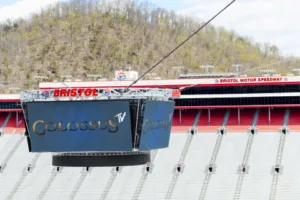Two thousand years ago, travelers approaching the Greek island of Rhodes could see a giant statue, made of iron and brass, shining on the horizon. Known as Colossus, it was considered a masterpiece of art and engineering, one of the seven wonders of the ancient world.
Today, a new metal titan is lighting up the grandstands at Bristol Motor Speedway (BMS). With four massive high-resolution screens and a half-million watt, 485-speaker sound system, Colossus TV is a marvel born of architecture, engineering and technology.
“Colossus was first imagined by Bruton and Marcus Smith, so we knew it would be big,” said Jerry Caldwell, executive vice president and general manager at BMS. “Every time I walk into the stadium I’m blown away by their vision, and by what our crew has accomplished. Basically, our build team put together a high-tech building, three stories tall, and hung it in the sky.”
First announced in October 2015, Colossus makes its debut on Friday, April 15, 2016. It’s a historic milestone, says Marcus Smith, CEO of Speedway Motorsports, Inc. (SMI), one that points toward the speedway’s future as a premier, neutral-site sporting venue.
“To go from the original designs and models to seeing and hearing the real deal — this has been a larger-than-life process, every step of the way,” said Smith. “The unveiling of this system at Bristol Motor Speedway means a whole new level of entertainment and interactivity for fans of NASCAR, for football fans, for guests of events we haven’t even imagined yet. Colossus has transformed Bristol, and the state of Tennessee, into one of the most versatile and amazing entertainment destinations on the planet.”
Steve Swift, vice president of operations and development for Speedway Motorsports, Inc. (SMI), headed up the crew working on Colossus. Since the project broke ground in late 2015, he has pulled together experts from a wide range of disciplines, including geology, metallurgy, electrical services, architecture, engineering, crane operations, audiovisual tech, sound engineering and more. His crew is made up of literal heavy lifters, specialists who came together to achieve a series ofbiggests, firsts and never-befores.
“We do a lot of construction,” Swift said. “We know how to make things work. But no one at SMI, or any of our other partners, had ever tackled a challenge like Colossus. When you need to find out the procedure for suspending a 78-ton screen frame, you can’t just pick up the phone and say ‘Hey, buddy, how does this work?’ Nobody knows how to do it. So you put a lot of smart people together in a room and figure it out.”
Start to finish, it took 200 workers 155 days to complete Colossus, a feat that included assembling approximately 700 tons of footings, framing, towers and cabling. Companies involved in the build featured audiovisual experts, such as GoVision, Community Professional Loudspeakers, Point Source and Panasonic Enterprise Solutions; contractors including Hayward Baker Geotechnical Constructors, Baker’s Construction Services, Rentenbach and EA Electric; Barnhart Crane & Rigging, and the entire BMS operations staff.
Throughout the process, Swift says the team met, and overcame, a range of unexpected trials. Among the biggest? Lifting the massive metal halo that suspends the screens.
“Last December the towers were up, the cables were here, and we were trying to figure out the process of raising the halo,” he said. “All the connections had to be made at the same time, while the structure was in the air. That was a very complex and challenging process with a very tight timeline. Someone suggested keeping the old infield scoring pylon in place, just in case we couldn’t get it done in time. I jumped in and said no. Not an option. So the pylon came down, and our safety net was gone. That was a very chilly winter day.”
Finally, weeks later, with the help of scale models, an intricate system of pulleys and blocks — and a dozen different cranes positioned in and around the stadium — the halo rose to its new home above the infield.
“Watching everything come together was amazing,” Swift said. “There were some late nights with the Musco lights burning, and freezing cold days when we were hanging steel, but the team made it look easy. All of us can look back now, laugh, and appreciate everything we went through together.”
Colossus is so big it already has its own fan page on the BMS website, and now that the public has gotten a peek at the behemoth, new questions are coming in.
“The favorite question people ask right now is whether a pass or punt during the Pilot Flying J Battle at Bristol will bounce off a screen,” Caldwell said. “When you’re not in the stadium you forget just how vast that space is. So the answer is that Colossus’ screens are positioned higher than what the NFL requires.”
Additionally, since the system is intended to be a permanent structure, there have been numerous inquiries about how Colossus reacts to wind, weather and lightning.
“Before a drill ever touched the BMS grounds, everything about Colossus was carefully planned out,” Swift said. “We worked hard to preserve Bristol’s famous sight lines. We worked hard to make the screens resistant to lightning, wind, hail, all kinds of weathering. During the build, we had sustained wind speeds of 30 miles per hour. One gust went up to 50, and everything performed perfectly. We listened to our experts and designed in every known precaution, and everything meets or surpasses code. Colossus is designed to endure.”
Crowds at this weekend’s Bush’s Beans Pole Day, XFINITY Series Fitzgerald Glider Kits 300/PittLite 125 doubleheader, and Sprint Cup Series Food City 500 will be the first to see Colossus come to life. Tickets are still available for race weekend by visiting www.BristolTix.com or calling (855) 580-5525.

